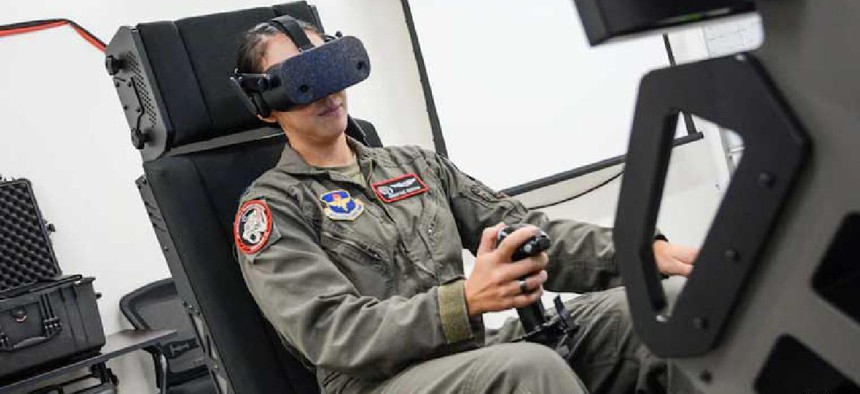Cloud, off-the-shelf gaming equipment expands flight training options

With virtual reality headsets, rubber pedal controls and video gaming chairs – along with cloud-based learning management -- the Air Force is building training systems that can be deployed to service members worldwide.
The Defense Innovation Unit and Google Cloud have entered into an agreement with the Air Force to modernize pilot training.
Through the artificial intelligence-driven Joint Immersive Training System (JTS), the 19th Air Force, Air Education and Training Command, will use off-the-shelf equipment such as virtual reality headsets, joysticks, throttles, rubber pedal controls and video gaming chairs to build training devices that can be deployed to service members worldwide.
Already in use at Randolph and Vance Air Force bases with student pilots, the system aims to overcome three main limitations with current training, Eric Frahm, the DIU program manager on the effort, wrote in emailed responses to GCN.
“First, it isn’t scalable beyond current production levels without massive infusion of additional resources,” Frahm said. “Second, a lack of training assets limits students’ ability to practice and learn through repetition and personal discovery. Third, it lacks sufficient use of data to produce meaningful insights into student and instructor performance -- we know relatively little about individual students’ strengths and weaknesses and even less about how effective individual instructors are at producing competency.”
Additionally, current training assumes all students need the same access to the same lessons presented in the same order, he added, likening it to an industrial production model that “turns out students on a strict schedule.” Although it works, the Defense Department needs to train more pilots that the current model allows.
“Modern technology offers pathways to individualize training and break free from these limitations,” Frahm wrote. “The JTS platform will empower DOD flight instructors to use modern adult learning methods while managing risk and ensuring wide access to simulation technology. By eliminating access to training devices as a barrier to training, we can accelerate the pace of learning.”
As part of the yearlong contract, DIU will deploy about 50 devices at the bases to train students on the T-6 and T-38 aircraft.
Another benefit is the ability to collect data on students’ and instructors’ performance, which can allow for self-paced training and individualized instruction. In the end, Frahm said he expects to have a continuous process of improvement built on a foundation of modern technologies and the ability to acquire and seamlessly integrate more in the future.
“It accommodates a landscape of changing technology devices that may render the best training experience (i.e., a new set of pedals come out or a new headset) … creating this plug-and-play extensibility,” said Mike Daniels, vice president for Global Public Sector at Google Cloud.
Not having to use purpose-built equipment at specified locations is crucial to expanding training accessibility. By putting its learning management system in the Google Cloud, students and instructors can access it anytime from anywhere. “That’s, to me, the real underlying aspect of this,” Daniels said. “Ideally, there will be a heightened output with respect to training and the ability to get training out quickly so you really get down that learning curve faster as a result. And then secondly, theoretically, the quality of instruction and the evenness of instruction can be delivered the same around the world.”
Google Cloud is also using its Apigee application programming interface platform to create connection points back to the data repositories the Air Force needs for training. For instance, each aircraft is different, so each classroom and instruction setup is different, Daniels said.
He said making extensible commercial hardware and not requiring students to travel to specified training locations will also save the Air Force money.
In addition to Google for cloud infrastructure, cybersecurity and scalable computing, JTS is tapping three other commercial partners:
- CAE is building a learning management system to monitor the competencies students learn.
- Vertex Solutions built the software and hardware and is providing on-device software design, logistical support and user acceptance testing.
- Discovery Machine is building an AI-based autonomous flight instructor to supplement human teachers.
“Collaboration has been key,” Frahm wrote. “In just three months, the JTS team has designed, built and integrated an immersive training device, a custom software ‘stack’ of tools on the device, cloud infrastructure and a highly advanced learning management system…. Within the next three months, we’ll do it all again and deploy a new version of the device based on the lessons we’ll learn” at Randolph and Vance.





